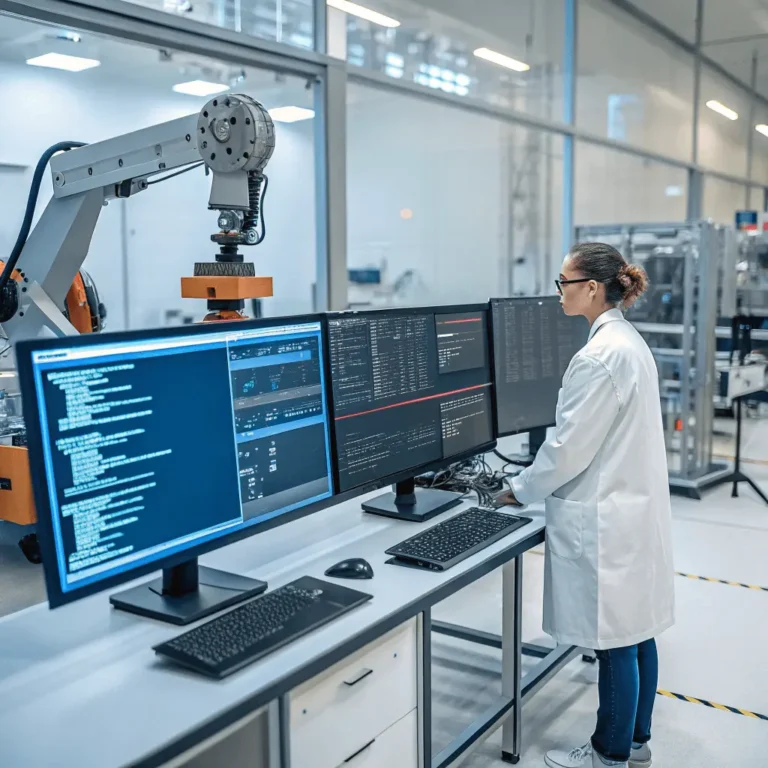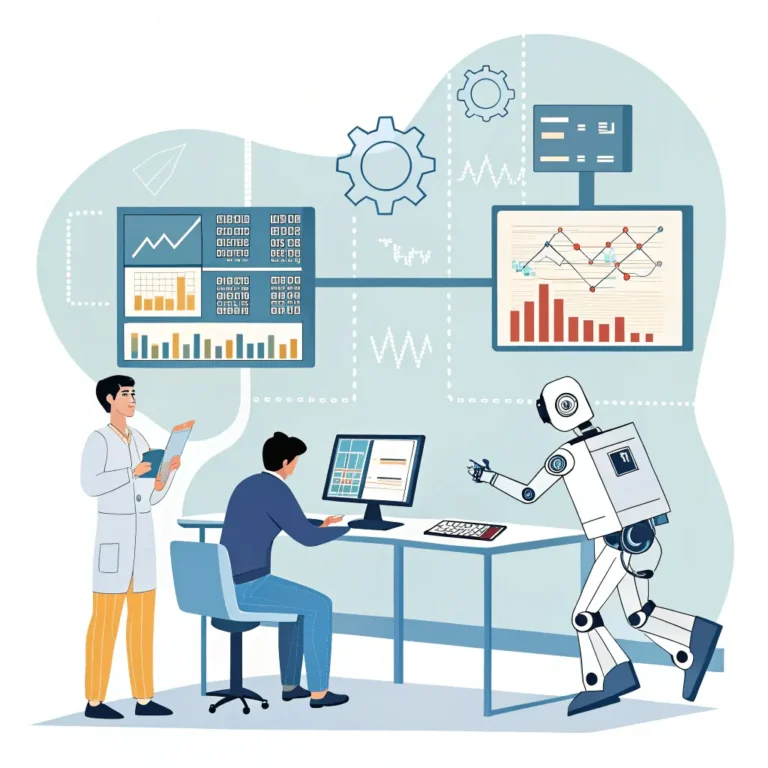
As organisations aim for shorter development timelines, better quality, and more efficient testing methods, AI has emerged as a significant asset in the software testing era. By integrating AI into QA testing, teams can improve their testing procedures. Quality assurance strategy utilizes artificial intelligence, machine learning algorithms, deep learning models, and various AI testing tools to boost efficiency and speed while decreasing human error and lowering costs.
Depending on the testing requirements, testers can assess software manually or automatically. Each method has advantages and disadvantages; when implemented correctly, automated and manual testing can be extremely effective. While automated testing offers speed and precision, manual testing provides quality and functionality.
In this article, we will explain a basic understanding of AI in QA and its benefits. We will also cover how AI helps in balancing automation and manual testing to enhance the reliability of software. Most importantly we will discuss some best practices to follow in incorporating AI into the QA process.
Understanding AI-Driven QA
AI is already having a substantial effect on quality assurance processes. The responsibility of managing test scripts has shifted to AI and machine learning technologies. Self-healing tests and scripts are now commonly available on major platforms, leading to a decrease in maintenance tasks. Currently, this capability is essential for any modern QA automation team.
One of the most prominent applications of AI is in the generation of exploratory scripts under supervision, where the AI learns from prior testing experiences and modifies its testing strategies accordingly, including the validation of results. This can lead to significantly broader application coverage and can help uncover potential issues that manual or traditional automated testing may overlook.
The process of developing and maintaining test scripts has traditionally been a difficult and prolonged effort. AI technology enables the testing process to become much more efficient. AI systems understand test case workflows and validations to create test scripts automatically, which lightens the workload of QA teams.
The most important impact of AI in quality assurance relates to its ability to deliver enhanced insights about defects found within the build. QA teams gain better clarity on the testing process through AI automation, which enables them to identify issues in the early development stages.
Evolution of the AI era
Back in the very early days, developers used to write code and manually test it themselves. During software interaction, testers provided valuable input about particular usability issues. However, the time and effort needed for executing tests manually led to delays in releasing software and thus increased demand for efficient test execution. This led to the introduction of automated testing, which employed specialized tools to run predefined test cases.
The introduction of automation in the field of QA reduces the time taken to perform the tests, and QA teams could run a higher percentage of test cases with less time being spent on them. However, the move into automated testing was not without its associated difficulties; the setting up of automated testing frameworks took a heavy investment in front-end tooling, training, and expertise.
Limitations with manual and automated testing methods became reasons to migrate focus toward the integration of AI into the QA process. AI-driven testing makes use of machine learning algorithms combined with advanced analytics to extend testing capabilities, easing some of the challenges of past methodologies. The innovative idea of self-healing tests is perhaps one of the most important innovations in AI-powered testing. A large set of testing data can be analyzed with more efficiency through machine learning algorithms to discover defects.
The choice between manual and automated testing creates a complex dilemma since they present advantages and disadvantages for the testing process. Many factors determine the selection between manual and automated testing since projects often require specific approaches. AI algorithms can balance automated and manual testing and help QA teams enhance the reliability of the software.
Benefits of AI for QA to Maximize Software Reliability
Organizations gain remarkable advantages from AI implementation during the quality process to achieve higher levels of software quality and operational effectiveness, alongside satisfied users.
Automation
The automation of QA workflows becomes easier through AI as it handles time-intensive, laborious tasks such as data collection and analysis, defect detection, and quality control management. The implementation of Artificial Intelligence automates operations, which cuts down human requirements while accelerating processing workflows, thereby boosting total output.
Improved Accuracy and Consistency
Large datasets can be systematically analyzed by AI algorithms, which can also accurately carry out complicated calculations. By doing this, the probability of human mistakes and inconsistencies in the quality assurance process is reduced. AI can improve quality control by identifying anomalies and inconsistencies in data as well as patterns in it.
Improved Analysis of Data
AI possesses a remarkable capability to analyze enormous amounts of data and extract valuable insights from it. AI processes large data collections through quality assurance processes where it identifies relationships between data sources and detects underlying issues. The strategy enables organizations to prospectively solve problems while continually enhancing performance levels.
Predictive Analytics
AI can anticipate any quality issues before they develop by employing machine learning techniques. By identifying past data, AI algorithms can identify trends and patterns suggestive of possible quality problems. Organizations gain the ability to develop preventive strategies to reduce defects and improve software quality.
Real-time Monitoring and Notifications
The real-time monitoring of quality parameters by AI-powered QA generates alerts when quality standards are breached. This minimizes downtime and decreases the impact of quality problems through prompt solutions.
Quality Insights and Support for Decision-Making
Through AI technology organizations achieve beneficial insights and assistance which enhances decision-making for quality improvement efforts. By analyzing data from various sources, AI can identify crucial quality elements, propose enhancements, and aid in the decision-making processes. Through artificial intelligence, organizations gain the ability to make decisions from data sources while improving their quality procedures.
Continuous Learning and Flexibility
AI systems can continually learn and adapt based on new data inputs and feedback. This capability allows them to enhance their effectiveness and respond to evolving quality demands. AI-enhanced quality processes become increasingly intelligent and proficient as they learn from prior experiences and incorporate new knowledge.
Reduction in Costs
AI can assist in lowering costs associated with quality control and defect management by automating and refining the quality process. The early identification of quality issues, proactive resolutions, and greater process efficiency lead to cost savings and improved resource management.
Strategies for Incorporating AI in Quality Assurance
Working Alongside AI Effectively
Rather than perceiving AI as a replacement, think of it as a collaborator. Engage in cross-functional discussions with AI experts and developers to understand the AI models used.
Learn AI Basics
Get familiar with fundamental AI concepts, such as machine learning, neural networks, and natural language processing. This information allows for a more effective interpretation of AI findings.
Data Exploration
Look into AI-generated insights. Understand how AI identifies patterns, anomalies, and potential issues.
Feedback Loop
Provide feedback to improve AI models. If an AI tool misclassifies something, report it and help refine the model.
Maintaining High Testing Standards
Use human judgment as AI can’t replace intuition or context awareness. Test edge cases that AI might miss. AI models are trained on existing data, but novel scenarios may arise.
Integrate AI into the testing workflow
AI should be incorporated into the existing testing framework. Parts of the testing process, such as creating test cases and evaluating test results, might require to be automated.
While it is feasible to create and train unique AI models for QA testing, it is frequently more efficient to use AI testing platforms that have native or embedded AI capabilities and can be incorporated into current workflows. Such platforms can help save time, decrease complexity, and streamline the QA testing process. For QA teams, there are several top AI testing platforms, each emphasizing its special qualities. Lambdatest is one of them.
LambdaTest is an AI-native test orchestration and execution platform that can conduct both human and automated tests at scale. The platform enables testers to run both real-time and automated tests on over 3000+ browser-OS combinations and 10,000+ real mobile devices, including Safari for Windows.
The platform improves AI automation by minimizing test flakiness with its AI self-healing function, which automatically adjusts to layout and design changes. This assures consistent, accurate testing by dynamically modifying locators, saving QA time, and reducing maintenance requirements even as the application changes.
LambdaTest also allows scalable, parallel test execution for cross-platform testing while also supporting common automation frameworks. This improves testing speed and reliability across the development process. Its low-code automation makes testing easier with less scripting, including visual test design, smart locators, and self-healing with less maintenance. All these features enable organizations to create a future-proof QA testing process that delivers exceptional results.
Bias Mitigation
Be aware of bias in AI models. Verify the impartiality and deal with any discriminatory results.
Human Oversight
Keep automated testing and manual review in balance. Humans catch nuances that AI might overlook. Together, manual testers and AI provide a strong synergy that leads to high-quality software development.
How does AI help in balancing automated and Manual Testing Together?
AI balances automated and manual testing by enhancing rather than replacing them. By automating regular tasks, data analysis, and intelligent test case development, while leaving human testers to focus on difficult circumstances and developing strategies.
Models for Predicting Defects
Organizations that use AI predict possible flaws by analyzing past data. By inspecting areas that have been identified, manual testers can verify these predictions. This guarantees lower risk, more focused testing, and fewer production surprises.
Regression testing that is automated
While organizations automate repeated regression testing with AI, manual testers concentrate on exploratory testing, identifying new issues, and ensuring overall quality. It leads to faster test cycles, more coverage, and expertise from humans enhancing AI efficiency.
Increased Efficiency and Speed:
Automation powered by AI speeds up repetitive and time-consuming testing activities. The efficiency benefits result in shorter testing cycles. Testers, freed from boring tasks, may concentrate on strategic planning, exploratory testing, and critical thinking. The combination of manual intuition and AI-driven execution boosts productivity.
Accessibility Testing with AI
AI-driven applications that integrate AI to identify accessibility issues (like colour contrast or screen reader compatibility). Manual testers can assist in validating AI results, which improves inclusiveness, meets accessibility standards, and provides a smooth user experience.
Enhanced Accuracy and Precision
AI algorithms are excellent at processing large datasets because they are not subject to human biases. Their capacity to identify complex patterns improves test outcomes. Consider a situation where minor flaws are missed by manual inspection, AI serves as a watchful sentinel, highlighting irregularities that could otherwise go unnoticed.
Test Prioritization
AI-powered analytics can prioritize test cases according to risk, code changes, and organizational impact. The method allows testers to focus their manual testing toward essential areas, thus maximizing resource effectiveness and testing scope.
Conclusion
In conclusion, software testing has entered a new era of efficiency and efficacy due to developments in artificial intelligence for quality assurance. There are several advantages of incorporating AI into the quality assurance process, such as transforming how it guarantees the application’s quality and enhances its reliability.
A balance between manual and automated testing approaches is crucial for achieving optimal outcomes in software reliability within QA. Instead of depending entirely on one technique or the other, teams should aim to apply each method based on the specific context.
Teams can increase efficiency while saving resources by carefully identifying quality assurance tasks and manual human involvement to prevent additional project complications. The collaboration of manual testing with AI capabilities has the potential to transform software testing efficiency, accuracy, and creativity.



